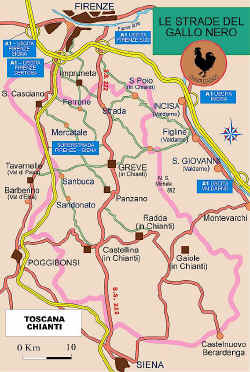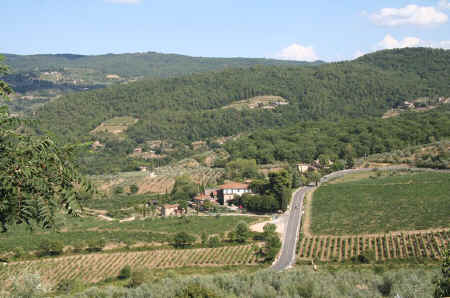|

Recently renamed SR 222 (Strada Regionale 222)
The
Via Chiantigiana is one of the most enjoyable motoring
routes in Italy. It runs directly south from Florence to Sienna through the
middle of the Chianti Classico wine zone of Tuscany, Italy, one of the most
instantly recognisable landscapes in the world. After passing
Ugolino
Golf Course, the oldest golf club in Italy, the Chiantigiana runs upward and follows the ridges
between the
Val
d'Elsa and the
Valdarno, wandering from one
farmhouse and villa to another, from time to time passing through
villages and small towns. These include
Strada in
Chianti,
Greve
in Chianti,
Panzano in Chianti,
Castellina in
Chianti. The towns of
Impruneta,
Lamole,
Volpaia
and
Radda in Chianti
are just a short distance
along side roads from the via Chiantigiana and can be visited by
following the network of secondary roads that link them together. Other short diversions
take the visitor through beautiful hillscapes to
Montefioralle
and
Badia a Passignano
to the west, and to
Gaiole in Chianti
and
Badia
a Coltibuono
to the east. The area around Gaiole in Chianti is particularly rich in
castles and chapels
including the castles of Vertine, Meleto, Barbischio and Brolio.
The castles area can be toured by turning off the Via Chiantigiana
at Castellina and heading through Gaiole, exploring the back roads
and then continuing on to Castelnuovo
Berardenga.

Map
of the Chianti Classico territory, bisected
north-south by the Via Chiantigana (SS222)
The territory traversed by the Via Chiantigiana has been one of the most important wine producing regions in Italy for over two centuries. In fact, it was the
Habsburg-Lorraine ruling family, most notably Leopold I, Grand Duke of Tuscany,
who, during the 18 C and 19 C, began cultivating the grapes that would become modern Chianti. Since the 1920s, this territory has been the official area of production for the
Consorzio del Vino Chianti Classico Gallo Nero
wine makers consortium. It was under the Lorraine government during the
19 C that
Bettino Ricasoli, a landowner and highly accomplished
agronomist, began
codifying the formula of Chianti wine. Ricasoli was born at
Brolio
castle and played an important role in the unification of Italy,
succeeding Cavour as premier of unified Italy. Many of the dirt tracks that ran between Florence and
Sienna were opened up and turned into proper roads after
unification and this contributed greatly to the development of local agriculture over the following century, especially wine production. Until that time, the lack of decent roads had been a severe impediment to agricultural growth in the Chianti region, despite reforms instigated by Grand Duke Leopoldo. These reforms had aimed to
transfer land-ownership to the local farmers from monasteries. The typical Chianti landscape that we see today is the result of these reforms as they encouraged farmers to extend their fields
into the woodland that grew over much of the area and which still
covers a large proportion of the territory. The classic picturesque views of the Chianti countryside that we see today may seem timeless, but in reality
they have only existed for the last two hundred years. Before that, the region was much more wild and
overgrown with only the Via Chiantigiana as a half-way passable
all-weather road from Florence to Sienna.

The Via
Chiantigiana as it curves past Villa Montagliari upwards to
Panzano.
|